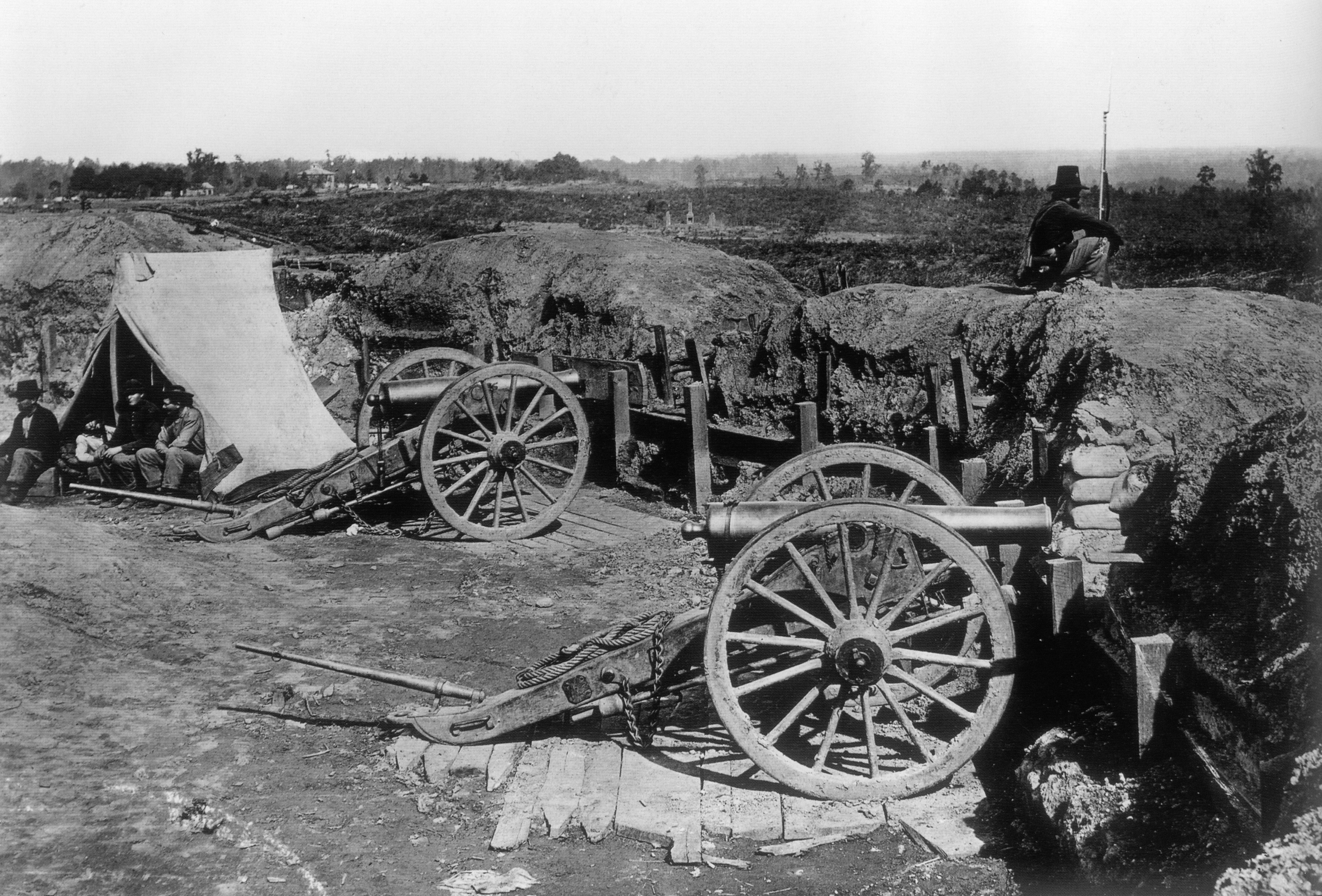
I
would like to give my heartfelt thanks and gratitude to John C. McCall Jr.
I met John and his input helped me to make this site more accurate.
Over the recent past, I have come to discover a lot of the things I
have been told about the Fox are historically inaccurate. During my
first public tour of the Fox (that I was a participant in, not giving
the tour myself) after being away from it for many years, I was shocked
to hear even more inaccurate history being told to those who came to
learn about the Fox. I also want to thank Rick Flinn
who also provided assistance via the Internet. Finally, I want to thank
all of you who have been dropping me emails and pointing out my
grammatical flubs and gaffs.
Part of the intended purpose of this website is to discover the truth
regarding the fascinating and complex history of the Atlanta Fox
Theatre. If anyone has historical information regarding the
Fox
that can be proven to be accurate and not hearsay, I will make changes
to this site to reflect that new information. E-mail me
if you have anything you would like to offer.
1849: The first documentation I have found regarding the property that the Atlanta Fox Theatre sits on states that in 1849 the property was part of a 405-acre farm owned by Mr. Richard Peters. The property stretched from present day North Avenue to Eight Street, Argonne Street to Bedford Place and beyond Plum Street. Mr. Peters has another place in local Atlanta history in that he established the first streetcar line in the city.

1878: The property which included the location at which the Atlanta Fox Theatre would be built on was purchased by Hannibal Ingalls Kimball, an entrepreneur and city planner.
1880s: Sometime in the 1880's, the exact date not known, a house was built for Colonel Willis E. Ragan on the corner of Peachtree and Kimball Streets. The house was a designed to be a showplace mansion with magnificent gardens.
 1889:
On December 8th, thirty-two Knights Templar and
Scottish
Rite Masons meet to organize a Yaarab Temple Shrine
in Atlanta. Henry Stockdell, who also founded the Capital City
Club, spearheads the group. The Ancient Arabic Order
of
the Nobles of the Mystic Shrine, or more commonly
referred
to as Shriners, are an Order
appendant to Freemasonry.
The Shriners employ a Middle-Eastern theme and establish meeting
halls they call "Temples" or "Mosques" across
the continent. It must be empathized that using this decorative
theme, now perceived as "politically incorrect" was
adopted in an earlier time with no regards to religious or political
ideology. The organization and its members maintain neutrality
to Islam as a religious tradition.
1889:
On December 8th, thirty-two Knights Templar and
Scottish
Rite Masons meet to organize a Yaarab Temple Shrine
in Atlanta. Henry Stockdell, who also founded the Capital City
Club, spearheads the group. The Ancient Arabic Order
of
the Nobles of the Mystic Shrine, or more commonly
referred
to as Shriners, are an Order
appendant to Freemasonry.
The Shriners employ a Middle-Eastern theme and establish meeting
halls they call "Temples" or "Mosques" across
the continent. It must be empathized that using this decorative
theme, now perceived as "politically incorrect" was
adopted in an earlier time with no regards to religious or political
ideology. The organization and its members maintain neutrality
to Islam as a religious tradition.
The Shriners often participate in local parades riding comedy versions of cars and motorcycles. They are recognizable by their elaborate red fezzes. In modern times, Shriners are most visible at street corners asking for donations for their hospitals and their traveling circus. The Shrine's charitable arm is the Shrine Hospitals for Children, a network of twenty-two hospitals in the United States, Mexico and Canada. They were originally formed to treat young victims of Polio, but as that disease was controlled, they broadened their scope, especially with orthopedic and burn injuries.
1890: The charter for the Atlanta Yaarab Temple was granted at the 15th annual Imperial Council meeting of the Ancient Arabic Order of the Nobles of the Mystic Shrine in Chicago in June of 1890.
1916: The Atlanta Shriners announce the project of building a Shrine Mosque as "Yaarab Temple's contribution to the civic growth of the Gate City of the South".
1925: The Yaarab Temple begins to formalize their plans for their Mosque. An architectural competition is held for a building that will "Out-Baghdad Baghdad". The ambitious plans for the Mosque include much more than a clubhouse for the Shriners. Integral to the structure will be a civic auditorium, capable of seating up to 7,500 in the audience. The Shriners are passionate about including the civic auditorium in their mosque as it was seen as a true civic asset for the city of Atlanta. The main entrance for the patrons would be located on the Kimball (Ponce DeLeon) side of the building with the Shriner's entrance on Peachtree Street. The Peachtree Street side of the structure would be the actual Mosque side of the building that would contain spacious club and lounge rooms, the Recorder's office, a writing room, reading room, library, billiard room, cloak room, check room, cigar stand, card room, soundproof practice rooms and storage space for the Shriner's parade unit, the "Million Dollar Band", The Percussion and Kazoo- playing Oriental Band, The Ceremonial singing Chanters, The Precision-drill marching Patrol, and the ritual Degree Teams. There were also plans for a restaurant should there be enough space.
A building fund is established in October and a fund raising campaign that lasted only 25 days brought in over a million dollars to fund the project.
A ground breaking ceremony is held on November 23rd to mark the beginning of construction, although it would be over two years before it would officially get underway.
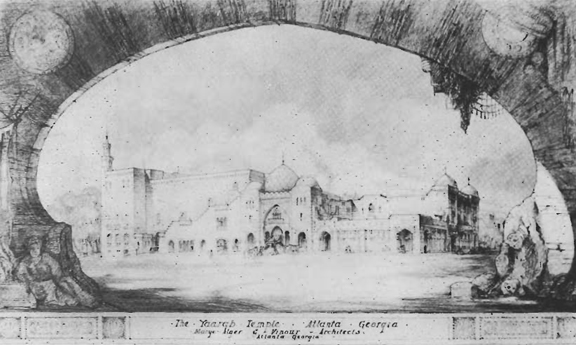
1927: The Shriners announce the local architectural firm, Marye and Alger, has submitted the winning design for the Atlanta Mosque. It is a flamboyant interpretation of a mosque with onion domes, towers, horseshoe and lancet arches, and a minaret. Olliver J. Vinour, a young and upcoming architect, along with P. Thornton Marye design the new mosque. Vinour's design work was so impressive, he was immediately made the junior partner to Marye and Alger. Vinour went on to design the Atlanta Railroad Terminal Building, The Atlanta City Hall, and the Southern Bell Headquarters in Atlanta. In the concept drawing above, notice how the concept almost exactly matches the actual structure, with exception to the larger 3-story section that would face Peachtree Street.
- The Yaarab Temple enters into negotiations with the Fox Films Corporation's theater division for a long-term lease on the civic auditorium. Fox Vice-President Saul E. Rogers sees potential and great benefits in having a Fox Theatre in Atlanta.
- With the projected cost of the new Yaarab Temple Mosque escalating well beyond what the Shriners could afford, drastic steps are suggested to make the project viable. One of the more drastic suggestions is to divide the project into two separate building projects that would allow the Shriners to build the "Peachtree Street Section" first, then the civic auditorium later. It was felt that the Shriner's "Mosque" could be built with the current funds available without having to secure a mortgage loan to build the auditorium. The settled-upon plan involved securing the long-term lease of the auditorium from the Fox Theater group. With the lease in hand, the Shriner's felt that it would provide the funds needed to secure and pay for a mortgage to go ahead and build the entire complex.
1928: The Yaarab Temple and Fox Theaters sign a twenty-one year lease on the Mosque's Civic Auditorium. Fox asked for a few alterations to the design of the building and fortunately they were very easy to do. Fox felt that Peachtree Street would be the more traveled road than Ponce DeLeon, so he asked that the main entranceway to the auditorium would be moved from the Ponce DeLeon Avenue side of the building to the Peachtree Street facade.
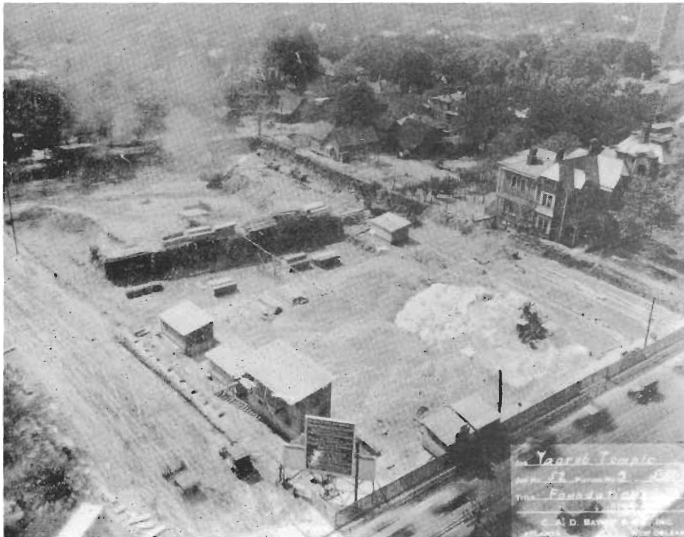 -
Construction work begins on the Atlanta
Shriner's Yaarab
Temple Mosque with the clearing of the property and the
laying
of the massive complex's foundation. After months of preparing
the site, the cornerstone was laid on June 14, 1928. (The photo
at right was taken in May of 1928.)
-
Construction work begins on the Atlanta
Shriner's Yaarab
Temple Mosque with the clearing of the property and the
laying
of the massive complex's foundation. After months of preparing
the site, the cornerstone was laid on June 14, 1928. (The photo
at right was taken in May of 1928.)
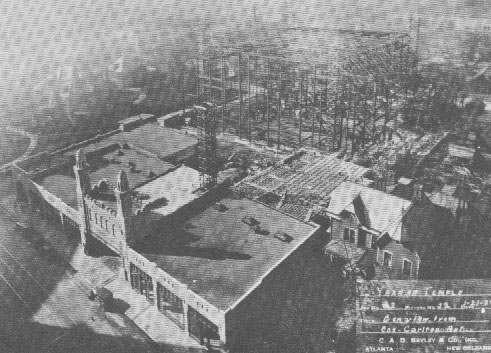 - While
the entire complex is still under
construction, the store fronts are completed and ready for occupancy.
This was important to the Shriners as once the stores could be
leased, they could start genetating important much needed revenue.
- While
the entire complex is still under
construction, the store fronts are completed and ready for occupancy.
This was important to the Shriners as once the stores could be
leased, they could start genetating important much needed revenue.
- In October the building committee reports that once again, they are in a financial crisis. In order to make ends meet, the decision is made to heavily revise the construction plans for the Peachtree Street side of the building. The upper three floors of club rooms that were to be in front of the banquet hall are eliminated. A planned gymnasium is converted into a large 140-foot deep arcade leading to the lobby of the auditorium. In addition to the revisions to the front of the complex, several changes were made to the stage in the auditorium in order to make it a state of the art performance area. Some of these changes included the incorporation of hidden microphones and multiple stage lifts.
1929: Construction on the Atlanta Shrine Mosque conitnues. Because of the stock market crash in October, thousands of companies are immediately put out of business and millions are without work. Yet, the Fox Theatre in Atlanta is too close to completion and work continues. The business situation does not leave the Fox unaffected by the situation as suppliers of materials or fixtures for the building do not deliver contracted materials for the buildings. Noted examples of things that never reach the Fox include the main chandeliers for the auditorium and pipes to fully complete the Möller organ. Work arounds and compromises are made in order to open the building on time.
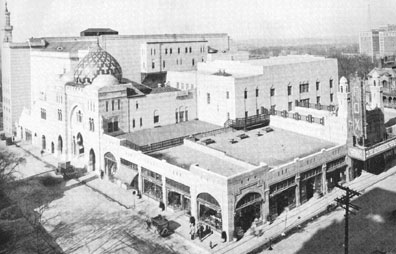 The Atlanta Fox Theatre opens 18 months after the
cornerstone
was laid on December 25, 1929. Admission prices range from 15
to 75 cents. There are two shows that day at the Fox. The first
is a matinee that was followed by the grand opening premiere gala
that evening.
The Atlanta Fox Theatre opens 18 months after the
cornerstone
was laid on December 25, 1929. Admission prices range from 15
to 75 cents. There are two shows that day at the Fox. The first
is a matinee that was followed by the grand opening premiere gala
that evening.
The premiere show began at 8:30 Christmas evening with the house organist, Iris Vining Wilkins performing on the "Mighty Möller" pipe organ. Enrico Leide then led the Fox Grand Orchestra to play "This Shrine of Beauty", a variation of Pomp And Circumstance, March #1 by Sir Edward Elgar. This was followed by Walt Disney's first talking cartoon, "Steamboat Willie", starring Mickey Mouse. The Master of Ceremonies, Don Wilkins (husband to Iris) then officiated over the rest of the live performances including a sing-a-long, and the Fanchon and Marco dance troupe's performance of "Beach Nights" performed by their "Sunkist Beauties" that incorporated a 12 girl dance chorus of Atlanta natives. Also on the bill were The Kitaros, a Japanese acrobatic trio; Davis and LaRue, a comedy team; Art Hadley, a musical cartoonist; the dance team of Bradley & Evain; Maxine Doyle, a musical-comedy artist, and finally Jean & Jeanette who were billed as "The Singing Sisters". The projectors started to roll again with the latest Fox Movietone Newsreel, and almost as an anticlimax to the evening, the feature film unspooled. That first film shown is Salute, directed by John Ford and David Butler. The film starred George O'Brien, Helen Chandler, William Janney, and Stepin Fetchit. The plot of the film was described, as "John Randall is an Army cadet at West Point His younger brother Paul is a midshipman at the Naval Academy. John contrives to help Paul's timid romantic interest in Nancy Wayne by pretending to be interested in her himself. Paul, however, takes offense, and determines to beat his brother in the Army-Navy football game on purely personal grounds. Meanwhile, Paul and fellow midshipman Albert Price are hazed and tormented by upperclassmen." The film's reviews make this a less than memorable movie.
- The Yaarab Temple conducts its first business meeting in the Fox on December 27th, 1929.
1930: The Yaarab Temple dedicates their new mosque on New Year's Day. Because the Shriners are a secret society, not much detail of what transpired at that function is known, however, in the 1990s a woman visited to the Fox Theatre to visit who claimed she was a chorus girl was employed for the event. She was tucked into a ceremonial cake that she popped out of at the appropriate moment.
- The Oriental Band Unit of the Yaarab Temple subleases the Banquet Hall (Later renamed the Egyptian Ballroom) for $5,000 ($100 per weekend) for the remainder of 1930, then $5200 for the next six years. Their weekly dances made sufficient money to pay for the room rental plus the unit's traveling expenses to other Shrine functions.
- William Fox is leveraged out as the head of the Fox Film Corporation that is now mired in deep debt. In August, Fox Films Corporation discontinues its management of the Atlanta Fox Theatre. Loew's Incorporated assumes management of the Atlanta Fox Theatre. (This is somewhat of a grey area of historical fact. I do not know whether this meant that Fox Films gave its lease over to Loews, Under a corporate deal Loews started to manage Fox Theaters for Fox Films as with the competititve nature of the film industry, this is doubtful, or if Fox defaulted on its lease and Loews assumed the remainder of the lease or took out a new contract with the Yaarab Temple.)
When the Atlanta Fox begins operation under the Loew's banner, it becomes the flagship of the Loew's chain in Atlanta with the Loew's Grand becoming a second-run house.
While the Atlanta Fox Theatre bears the Fox name, it only operated as a true Fox Theater for less than 8 months.
1931: The membership of The Ancient Arabic Order of the Nobles of the Mystic Shrine is decimated due to members not being able to renew their memberships because of the hard times during the Great Depression. While the economic picture is very bleak, the Yaarab Temple's Treasurer is optimistic that the Shriners can pay their bills, especially the mortgage on the Mosque. However by July, the Shriners have fallen badly behind in paying their mortgage.
- Trust Company of Georgia goes to court to being foreclosure proceedings on the Atlanta Shrine Mosque in November of 1931.
1932:
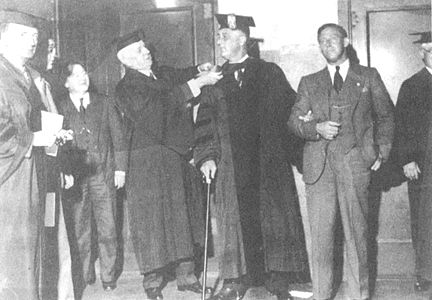 The
Fox Theatre is used for the graduation ceremonies for Oglethorpe
University. In attendance as an honored guest is Franklin
Delano Roosevelt, Governor of New York and Democratic
candidate
for President of the United States. In November, Roosevelt wins
the presidential election and begins the first of his four terms
in office in 1933. The photo at left was taken backstage at the
Fox of FDR prior to him going on stage. Note his use of a cane
and holding on the arm of the man to his left to help walk. This
is one of a very few photos that show his mobility issues he had
from suffering the effects of Polio. Roosevelt took great care
to conceal his handicap from the public for fear it would be perceived
he would not be able to properly conduct the business of government.
The
Fox Theatre is used for the graduation ceremonies for Oglethorpe
University. In attendance as an honored guest is Franklin
Delano Roosevelt, Governor of New York and Democratic
candidate
for President of the United States. In November, Roosevelt wins
the presidential election and begins the first of his four terms
in office in 1933. The photo at left was taken backstage at the
Fox of FDR prior to him going on stage. Note his use of a cane
and holding on the arm of the man to his left to help walk. This
is one of a very few photos that show his mobility issues he had
from suffering the effects of Polio. Roosevelt took great care
to conceal his handicap from the public for fear it would be perceived
he would not be able to properly conduct the business of government.
- Fanchon and Marco dance troupe perform for the last time at the Fox.
- The Yaarab Temple files for bankruptcy.
- In June, The Fox Theatre ceases theater operations and closes to the public. The Fox was open for only 125 weeks, less than two and a half years.
- The Shriners last official meeting at the Fox is on June 17th. The membership of the organization is now down to under a third of what it was prior to 1929. At the meeting, the Divan declares their Shrine Mosque a White Elephant.
- On August 1st, Loew's Incorporated officially ceases management of the Fox. Loew's Vice President, Col. E.A. Schiller announces plans for a brand new Loew's Grand Theatre, but the plans fall through. Instead, the existing Loew's Grand undergoes major renovation. The auditorium and lobby are re-decorated in the then-popular Art Deco style. Once again the Grand becomes the flagship theatre for the Loew's chain in Atlanta, a position it would hold until it is shuttered in 1978.
- On August 7th, under the direction of N. Edward Beck, the Fox reopens for business. Beck announces an "all sound" motion picture policy (even though there is no evidence the Fox ever played any silent films prior to 1969) with stage shows to follow in the fall.
- In October, Enrico Leide, the original conductor of the Fox Grand Orchestra, assumes the position of General Manager. Jimmy Beers replaces Al Evans as the house organist, and a 20-peice stage band with Dave Love conducting becomes the house band. Stan Portopovitch forms a house dance troupe.
- The mortgage, held by the Trust Company Bank of Georgia, is foreclosed on the Atlanta Fox Theatre on November 12th.
- Fulton County Superior Court orders the Shrine Mosque and all of the Yaarab Temple assets to be sold at public auction after four weeks of advertising in the local newspapers. On December 6th, at 10:30am, Theatre Holding Company purchases the Fox at the auction for $75,000. Theatre Holding Company was a corporation created by the former bondholders of bonds issued by the Yaarab Temple for the purpose of raising funds to the build their mosque. The bondholders were left holding $357,000 in now worthless stock and bonds after the Shrine was found to be insolvent.
1933: The Fox auditorium is leased to Robert E. Wilby on September 2nd.
- The Shriners lease the Mosque portion of the Fox Theatre and remain in as paying tennants. They continue to use the Mosque portion of the Fox until 1949.
- The Fox becomes the home of the Atlanta Symphony Orchestra and in addition, the Fox hosts other community events including programs sponsored by the Atlanta Music Club.
1934: After less than a year, Robert Wilby's management of the Atlanta Fox Theatre ends in failure.
- The Fox is quickly leased to Atlanta Enterprises, owned by Arthur M. Lucas and William K. Jenkins. Both partners are members of the Yaarab Temple and up to this time they had been in business as promoters of a community theater company. This was their first experience in operating a movie house, an auditorium of over 2000 seats, and a theater in a "downtown" district.
1935: The City of Atlanta contemplates purchasing the Fox from Theatre Holding Company for use as its municipal auditorium. The Yaarab Temple is fully supportive of this plan as part of their original vision of the building was for it to be a civic auditorium for the city. A purchase price of approximately $725,000 is agreed upon with the city making a $110,000 down payment with the balance of $615,000 being paid over a 25-year period. Citizens and corporations come up with the down payment funds so the city would not have to raise that much capitol in order to make the deal happen.
- Mosque, Inc. is formed by attorneys Harold Hirsh and Marion Smith on behalf of an unnamed citizens group on March 21st. The stated intentions of the corporation are "to convey to the city attorney all revenues, first payment, and federal, state, and city taxes from the Shrine Mosque".
- While there were many that favored the purchase of the Shrine Mosque by the city, the plan had its detractors because of the Fox's history of continually loosing money. After heated debates, the city council voted 21 to 13 to purchase the Fox. Mosque Inc. purchases the Fox from Theatre Holding Company on April 19th for $110,00 in cash and $615,000 in bonds. On the same day, Mosque and the City of Atlanta signed an agreement whereby the City accepted the Fox.
- On May 1st, Lucas and Jenkins are told to vacate the Fox. From what transpires, they continue to operate the Fox as it seems they were given several months before they had to stop managing the Fox. It would seem their final vacate date was supposed to be after January 31, 1936 when an unexpected occurance takes place.
- The Yaarab Temple sign a 13-month lease with the City of Atlanta so that it could continue to use the portions of the Fox it was using.
1936: In January, the city has serious second thoughts about owning the Fox. With impending lawsuits challenging the legitimacy of the purchase, plus a projected $30,000 operating deficit by city financiers (not counting $9,000 worth of estimated taxes), the recommendation is made to turn the ownership of the Fox back to Mosque, Inc. This had to be done prior to January 31st in order to made the previous owners liable for the 1935 and 1936 taxes. The city council votes to turn the Fox back over to Mosque, Inc. on January 29th.
- With the Fox back in control of Mosque, Inc., Lucas and Jenkins agree to remain as operators of the auditorium. They sign a five-year lease for $30,000 per year.
1937: As a move to reduce taxes by having part of the Fox occupied by a non-profit fraternal order and to curry favor with important city officials, Mosque, Inc. offer the Yaarab Temple an incredible two-year lease on the parts of the Fox complex they use. The lease allows the Temple to use the Fox for only the cost of the utilities they use. The new lease is signed on September 1st.
1939: Lucas and Jenkins form the Georgia Theatre Company (GTC) to manage more theaters than just the Fox. In short order, GTC takes over the day to day management of the Fox. The banquet hall is officially renamed the Egyptian Ballroom and becomes the site of public functions, dances and social affairs other than just Shriner organized functions. GTC installs a neon sign above the Grand Staircase entranceway to the ballroom area that remains in place for over 50 years. GTC sets up its operational offices in the Spanish Room and the Grand Salon. It uses those offices until the theatre closes at the end of 1974. The Yaarab Temple is forced to relocate their operations from the upper rooms of the Fox to rooms in the downstairs service areas, however they are allowed the use of the Ballroom and Auditorium for large Shrine functions.
1944: The United States Government reopens anti-trust litigation against major studios
1945: The Atlanta Fox Theatre is named the most popular and successful theater in Atlanta.
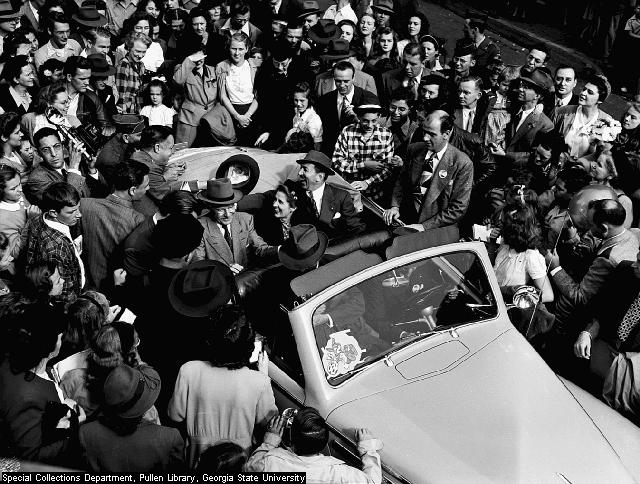
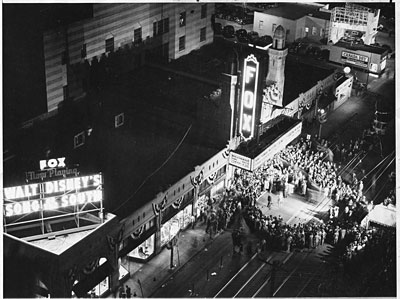
1946: The Walt Disney live-action and animated film, "Song of the South" has its World Premiere at the Atlanta Fox Theatre. The films premiere in Atlanta was due to Joel Chandler Harris being a resident of Atlanta and native of Georgia. Harris was the author of the Uncle Remus tales the movie was based on. In attendance for the premiere was Walt Disney himself.
- Mosque, Inc. announces plans for a major remodeling of the Arcade, foyer, and store frontage of the Fox. The work is to be supervised by Hal Pereira, a prominent theater architect. Work is never started, as I believe this is due in part to the next items in our historical timeline.
1947: The US Dept of Justice appeals after Supreme Court does not order major studios to divest their exhibition arms
1948: In May, the "Paramount Decree" is rendered by The United States Supreme Court. The Court rules that the movie studio's operation method of "vertical integration" is an illegal monopoly and orders Loew's Incorporated, 20th Century-Fox Films, and Warner Brothers studios to divest their exhibition/distribution arms . This forces the movie studios to spin-off its theater chains into independent companies. Mosque, Inc. its the Georgia Theater Company, of which a major partner was Paramount Studios, is forced to divest itself of theater operations. Mosque retains ownership of the Fox Theatre but is forced to lease the Fox to another film exhibitor.
- The Yaarab Temple purchases the old "Standard Club" located at 400 Ponce DeLeon Ave and relocates its operations to there from the Fox complex.
1951: Mosque, Inc. leases the Fox to Wilby-Kincey Service Corporation, a film exhibition company run by former Fox theatre operator Robert E. Wilby and his new partner, Herbert F. Kincey. Since Wilby's time at the Fox in 1933, he has become a very successful operator of a large chain of theaters in the Southeast. While Wilby-Kincey Service Corporation operates the Fox as a Movie Theatre, the Georgia Theater Company retains its office location in the Spanish Room of the Fox. Wilby-Kincey will continue to manage the Fox until it is shuttered in 1975.Wilby-Kincey Service Corporation worked as a regional distributor of ABC Theaters.
- Noble Arnold assumes the position of General Manager of the Fox. He comes to the Fox from his tenure as circuit director for Wilby-Kincey operations in Durham, North Carolina. In addition to managing the Fox Theatre, he is also responsible for the operations of the Roxy and Paramount. Both theaters are on Peachtree Street down from the Fox in the Atlanta Downtown business district.
- While it was still played occasionally, the Möller organ is not in very good working order. Arnold orders a quick repair of the organ to bring it back to operational condition. Once the organ is in playable condition, Eddie Ford was named at the house organist.
1954: Because of the Fox Theatre's immense size, it was very hard for the theater to make a profit. GM Noble Arnold takes a policy of minimalism and does not perform maintenance or repair on non-essential equipment or fittings at the Fox. Because it was not an essential piece of equipment and only used on rare occasions, the organ falls back into disrepair to a point that it could no longer be played. The organ falls silent.
1953: The theatre undergoes a renovation effort, in order to increase patronage. A new CinemaScope screen was installed along with a multi-channel audio system that featured 36 speakers that line the auditorium walls. New carpet with a generic floral style pattern replaced the original carpet made specifically for the Fox and a new round concession stand was put in the center of the main lobby, replacing the old concession stand that was located to the immediate right of the arcade entrance.
1956: Elvis Presley performs to a beyond overflow crowd at the Atlanta Fox Theatre in May. I am told this is the same day Elvis signs his first contact with Col. Tom Parker to manage his career.
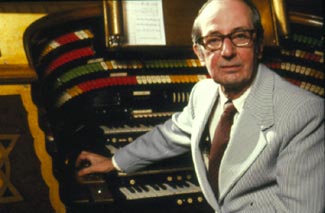
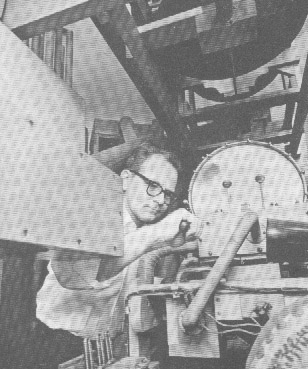 1962: The Atlanta Chapter of the
Theater Organ
Guild of America informed the Fox management that the group
wants to tackle the Fox's Möller organ as a volunteer
restoration
project.
1962: The Atlanta Chapter of the
Theater Organ
Guild of America informed the Fox management that the group
wants to tackle the Fox's Möller organ as a volunteer
restoration
project.
- Under the direction of project leader Joe G. Patten and after ten months of hard work, the Atlanta Fox Theatre's Möller organ comes back to life. The original date the organ was to have its debut from restoration was November 22, 1963 but was cancelled due to the assassination of President John Kennedy earlier that same day. The performance was rescheduled to Thanksgiving Day, November 28th with the new staff organist, Bob Van Camp, playing "Georgia On My Mind" as the first musical selection. The organ was then played continually during weekend movie shows. Joe Patten becomes the unofficial "Technical Director" of the Fox.
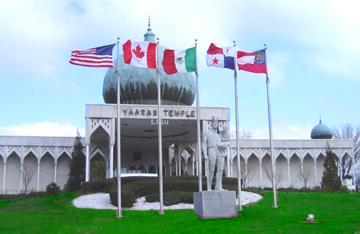 1964:
The Yaarab Temple build a new Mosque at
400 Ponce DeLeon Ave, approximately a mile and a half away from
the Fox Theater after a fire consumes the previous structure which
started life as
the old Standard Club. Like the Fox, the new Mosque features
modernistic
Arabic architectural styles that feature a prominent onion dome
at the main entrance, but the building is much less opulent than
the Fox. The Mosque continues to be the home for the Shriners to this
day.
1964:
The Yaarab Temple build a new Mosque at
400 Ponce DeLeon Ave, approximately a mile and a half away from
the Fox Theater after a fire consumes the previous structure which
started life as
the old Standard Club. Like the Fox, the new Mosque features
modernistic
Arabic architectural styles that feature a prominent onion dome
at the main entrance, but the building is much less opulent than
the Fox. The Mosque continues to be the home for the Shriners to this
day.
1965: the Atlanta Chapter of the American Theater Organ Society purchases a grand piano that had once been a part of the Kilgen organ in Chicago's Piccadilly Theatre for the Atlanta Fox Theatre. Joe Patton designs and constructs an interface to connect the piano to the Möller Organ. The piano can be played either directly or from the console of the Möller organ. When used, the piano sits on the center orchestra lift.
 1968:
The John Wayne film, "The
Green Berets"
has its world premiere at the Atlanta Fox Theatre on July 4th.
This is held in conjunction with the WSB Television
Salute
to America Parade in which Wayne was the parade's
Grand
Marshall. The film was a pet project of John Wayne, who starred
and directed the film, as a tribute to the men and women of the
armed forces in retaliation to the growing anti-war movement.
1968:
The John Wayne film, "The
Green Berets"
has its world premiere at the Atlanta Fox Theatre on July 4th.
This is held in conjunction with the WSB Television
Salute
to America Parade in which Wayne was the parade's
Grand
Marshall. The film was a pet project of John Wayne, who starred
and directed the film, as a tribute to the men and women of the
armed forces in retaliation to the growing anti-war movement.
- At night when the theater was closed and the traffic was greatly reduced outside, Bob Van Camp and Joe Patten make taped recordings of popular songs played on the Möller organ. Later on, the material is used to make a pair of records that were made available for sale to American Theater Organ Society Members as well as at the Fox to the general public. The first album was titled: "Here With The Wind". In 1997, the materials were digitally remastered and put on a double CD album "The Atlanta Fox Theatre Remembers Bob Van Camp at its Mighty Möller Pipe Organ".
1969: With Lee Erwin at the console of the Möller organ, the first silent film to ever be shown at the Fox is played. The movie is "The Eagle", the 1925 film staring Rudolph Valentino. Valentino played Vladimir Dubrouvsky, a lieutenant in the Russian army that catches the eye of Czarina Catherine II as well as many other women in the film. The film proves to be extremely popular and the Fox continues to show other silent films during special engagements.
1970: Noble Arnold retires as the Fox Theatre's General Manager on January 1st He leaves his post with the industry-bestowed title "Dean of American Theatre Managers." His tenure at the Fox runs for almost 19 years and is the Fox's second-longest serving general manager behind current GM, Edgar Neiss.
1973: The Atlanta Film Festival announces its relocation from the Memorial Arts Center to the Fox Theatre.
- Noble Arnold's successor, Mike Spirtous, changes the theater's policy of showing family entertainment films to ones that were for mature audiences. The change in genre causes patronage to severely decline. By this time, due to the great expansion of the number of suburban movie theaters and people's refusal to come to the downtown cinemas, pretty much all of the Atlanta downtown theaters fall into hard times and begin to show "B" grade and exploitation films.
- Due to low attendence and minimal staff, the Atlanta Fox's management ropes off the entrances to the upper floors of the auditorium and only allows patrons to use the lobby and orchestra level seating.
1974: Mosque, Inc. President John H. Stembler announces its intentions to permenantly close the Fox Theatre. It was decided the theater had become a major liability and could never be a profitable movie theater. Mosque, Inc. set about the task of finds a new owner for the property with the intent of having the Fox Theatre demolished.
The Bell Telephone System was looking for a large piece of property to locate their new Southern Bell division corporate headquarters on. Mosque, Inc convinced Bell the city block the Fox resides on was the perfect location and (most importantly) it was in the best interest of everyone to raise the Fox. In short order, Southern Bell purchases the Fox Theatre. What was to come of the property the Fox sat on? It was to be the site of one of the most mortal enemies of movie palaces: A parking lot.
- When the word gets out that the Fox has been sold and it going to be razed, the citizens of Atlanta go into an uproar that the Fox is going to be demolished. Uncharacteristically for Atlanta, a grass-roots campaign to "Save the Fox" quickly emerges, championed by a group of local high school students who picketed in front of the theater that attracts media attention at a critical time. A petition drive is undertaken and over 150,000 Atlantans sign the document demanding the Fox be saved. In addition to the local support of saving the Fox, a nationwide outpouring of support for the Fox is heard as well. After twenty years of loosing the majority of movie palaces, it is becoming recognized that the remaining palaces are a national treasure that should be preserved.
- May 17th, the Atlanta Fox Theatre is placed on the National Register of Historic Places. The register normally does not place buildings under 50 years of age (at the time, the Fox was 45 years old), but the Fox qualified under the exception of having "outstanding architectural merit". This gave the Fox immense status and recognition it needed in order to help press the point for the need to save the building as an architectural treasure. Since then, the Ponce Apartments, the Georgia Terrace Hotel, and the Cox-Carlton Hotel (now a Days Inn) have all been honored as National Historic Landmarks. There is no other instance of 4 individual buildings being named landmarks being in such close proximity to each other.
- In the summer of 1974, aided by Atlanta Mayor Maynard Jackson and the city's new Urban Design Commission, a new non-profit organization called Atlanta Landmarks whose charge will be to save, restore, and preserve the Fox was incorporated. Under the leadership of Arnall T. "Pat" Connell, Joe Patton, Beachamp Carr, Bob Van Camp, Robert Foreman, and others begin to develop a plan to save the Fox. Connell, a professor of architecture at the Georgia Institute of Technology (Georgia Tech), is named the organization's first president. While Atlanta Landmarks charter calls for it to preserve multiple landmarks in Atlanta, the Fox is the only landmark that ever comes under their care.
- An audience of over 2,500 assembled at the Fox on Monday morning, July 29, 1974, for a public hearing by the Georgia Senate Tourism Committee, a committee of the Georgia Legislature. The purpose of the meeting was to discuss at a public forum the prospects of saving the Fox. At the meeting the formation of Atlanta Landmarks was made public.
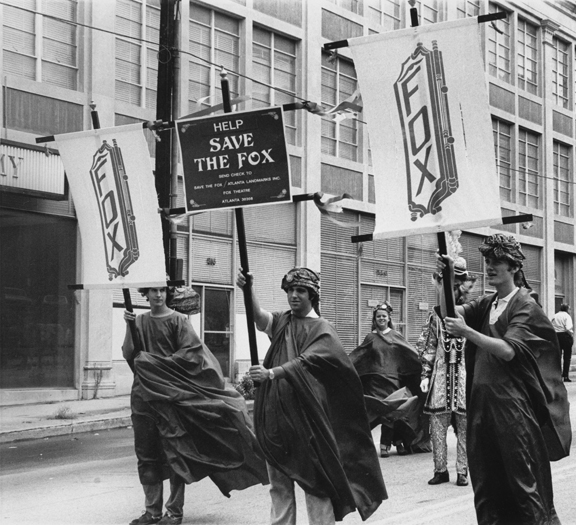 -
Southern Bell, and Mosque, Inc. are stunned at the situation they
now found themselves in. Going into this situation, they both
were convinced the Fox was nothing more than a neglected and unwanted
white elephant. They honestly felt that razing the Fox was not
only in their own best interests, but it was in the best interest
of the City of Atlanta. With the outpouring of voices demanding
the Fox be saved, Southern Bell and Mosque both tried to find
a graceful way out of this situation that would be acceptable
to everyone.
-
Southern Bell, and Mosque, Inc. are stunned at the situation they
now found themselves in. Going into this situation, they both
were convinced the Fox was nothing more than a neglected and unwanted
white elephant. They honestly felt that razing the Fox was not
only in their own best interests, but it was in the best interest
of the City of Atlanta. With the outpouring of voices demanding
the Fox be saved, Southern Bell and Mosque both tried to find
a graceful way out of this situation that would be acceptable
to everyone.
- In August, Atlanta Landmarks secured approximately $11,000 in state funds to underwrite a feasibility study for the Department of Natural Resources, Historic Preservation Section, on the Fox Theatre. The report would be used to justify the saving of the Fox and its re-purposing form a movie theater to an omnibus center for the performing arts. On September 4th, the economic consulting firm of Hammer, Siler, George & Associates are retained with a projected report date of December of that year on the Fox's reuse potential.
- Atlanta Mayor Maynard Jackson announces an eight-month moratorium on the issuance of a demolition permit to be used for razing the Fox Theatre on September 10, 1974. This move allowed time for Atlanta Landmarks to come up with a viable plan and the financing needed to save the Fox.
- Joe Tanner, Commissioner of the Georgia Department of Natural Resources, and Joe Patten on behalf of Atlanta Landmarks, receives the feasibility report on December 10th. In its conclusions, the report stated: "The proposed reuse of the Fox Theatre would serve as a hallmark for Atlanta - a symbol of Atlanta's recognition of its past to complement its growth and spirit as a national and international city."
- Local concert promoter Alex Cooley concludes his series of concerts "Midnight At The Fox" with a New Year's Eve/New Year's Day concert of the Greg Allman Band. Over 4000 attend which is feared to be the last live performance at the Fox.
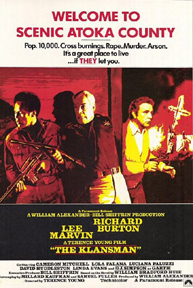 1975:
On January 2nd, The Fox Theatre closes as a
movie theater
after the 9:25pm showing of the Richard Burton / Lee Marvin /
O.J. Simpson film, "The Klansmen".
Many
people show up out of love for the building for the last show.
After the movie, general manager Mike Spirtous takes those in
attendance on a last tour of the building.
1975:
On January 2nd, The Fox Theatre closes as a
movie theater
after the 9:25pm showing of the Richard Burton / Lee Marvin /
O.J. Simpson film, "The Klansmen".
Many
people show up out of love for the building for the last show.
After the movie, general manager Mike Spirtous takes those in
attendance on a last tour of the building.
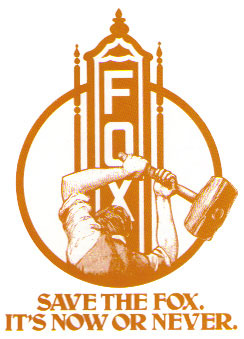 - After lengthy
negotiations, the five big
Atlanta banks agree to a loan, co-signed by Southern Bell, for
the purpose of Atlanta Landmarks to buy the remaining three-quarters
of the city block the Fox sits on.
- After lengthy
negotiations, the five big
Atlanta banks agree to a loan, co-signed by Southern Bell, for
the purpose of Atlanta Landmarks to buy the remaining three-quarters
of the city block the Fox sits on.
The plan had Southern Bell exchanging the Fox Theatre's deed for
the deeds for the property that Atlanta Landmark would then own.
Bell would build their office complex on the rest of the city
block that the Fox sat on, leaving the theatre intact. The plan
required very little alteration to the original plans Bell had.
Whereas a parking deck was to sit where the Fox is, it was moved
over to the other side of the Bell offices. The main high-rise
office building would remain located on the corner of Ponce DeLeon
and West Peachtree Street. Next to it would be a smaller office
building connected to the parking deck. In front of that would
be an open-air parking lot next to the Fox facing Peachtree Street.
The loan was formalized and the properties were assigned to their new owners on June 25, 1975. The purchase price of the remaining property on the "Fox Block" was 1.8 million dollars. The loan arrangements had this being paid off in one single payment, due in three years, with quarterly interest payments of approximately $360,000 being made starting in June of 1976. The loan was made with the agreement that each interest payment plus the payment of the principle had to be paid exactly on time. Should Atlanta Landmarks miss a payment by as little as one day, the demolishing permit was still in place and the mortgage would be foreclosed, and the building destroyed. All told, the final purchase price of the Fox Theatre, including closing costs and legal fees totaled approximately 2.4 million dollars. By my estimates, Atlanta Landmarks paid approximately $2,520,000 in the seven interest payments that were paid to the banks. This would make the total purchase price of the Fox Theatre come to almost 5 million dollars.
- Atlanta Landmarks takes possession of the Fox on June 25th, the same day the loan was closed. It is a testament to its design in that structurally, it was very sound and only a few things need repair in order to bring the theatre back to operational status. Atlanta Landmarks appoints Ted Stevens as General Manager. Stevens later goes on to manage Radio City Music Hall.
- The Fox Theatre opens its doors to the public for the first time since it ended operations on September 14, 1975 when the American Institute of Architects sponsors a public tour of the Fox. Over 4,000 people come to see the Fox during the three hours of tours.
- The Fox Theatre re-opens for operation on October 29, 1975. The first event is a benefit concert for the Fox by Linda Ronstadt. From this performance to present day, the Fox consistently makes a profit.
- Benefit concerts were regularly held along with movies and tours of the complex. For the first time in its life, the Fox was consistently making a profit. Performers such as Linda Ronstadt, Jack Benny, Liberace, Kate Smith, Lynard Skynard, Helen Hayes, Mitzi Gaynor, Cloris Leachman, Van Cliburn, Arthur Fiedler, and many others give benefit performances or donate time and effort as spokespeople to the "Save the Fox" campaign.
- Bruce Sutka is put in charge of working with restoration volunteers at the Atlanta Fox. The first project tackled is the repainting of the Egyptian Ballroom.
1976: Rick Flinn joins the Fox Theatre house staff, working with Ted Stevens. Later, Rick is named the first Restoration Director.
- Prince Charles of England attends the 1976 Bicentennial Gala at the Atlanta Fox. The event is held in his honor.
- A brass plaque is embedded at the foot of the Grand Staircase at the main entrance to the Egyptian Ballroom from the United States Department of the Interior proclaiming the Fox Theatre a National Landmark of Historical Importance.
- On June 24th, Atlanta Landmarks turns over its first check of $131,812.35 to the five area banks. 3,000 people have made donations to date.
1978: Since, the Fox didn't need many major repairs, most restoration work was put on an "as needed" basis. Volunteers under the direction of Bruce Sutka came to the Fox to help out with repairs and restorations. One of the first major restorations efforts that were undertaken was the restoration of the Egyptian Ballroom and the Grand Salon so they could be rented out for meetings and special occasions in order to raise additional revenue. Volunteer restoration went on for about two years until Mr. Sutka was abruptly terminated. Most volunteer restoration work was halted.
- Members of the International Brotherhood of Electrical Workers (I.B.E.W.) volunteer time and materials to help renovate the Fox Theatre's electrical service.
- The Atlanta Fox Theatre's mortgage is paid off in full on February 27th.
- The City of Atlanta donates funds to Atlanta Landmarks to put a new roof on the Fox Theatre
- As the Fox was being saved, construction crews were busy building the Bell Building directly behind the Fox on West Peachtree St. During construction, red-hot rivets repeatedly fall and hit the Fox. Twice, rivets fall into the Fox's air conditioning tower, causing fires. While both times there was considerable damage, fortunately the damage is contained to just the air conditioning tower.
- The Rolling Stones perform at the Fox. During the "Some Girls" tour, the Stones decided to play small venues and places they wanted to play or heard they should play. Local promoter Alex Cooley was contacted to make the arrangements. Because of the immense secrecy and extreme security measures that had to be taken, the event lost money. In order not to tip off anyone to what was going to happen, the tickets and the actual booking were made for the imaginary band, The Cockroaches. Patty Smith was the warm up act. After the event, members of the Fox staff join the band for an after-hours party at the Agora Ballroom across the street.
- Donations, pledges, and challenge pledges are made until finally on paper it looks like all the money needed to completely save the Fox was raised. The call goes out for all pledges and challenge pledges to be remitted and the money is gladly given. Fox was not only saved, but it was done months ahead of time and there was a cash surplus to put back into the Fox for restoration.
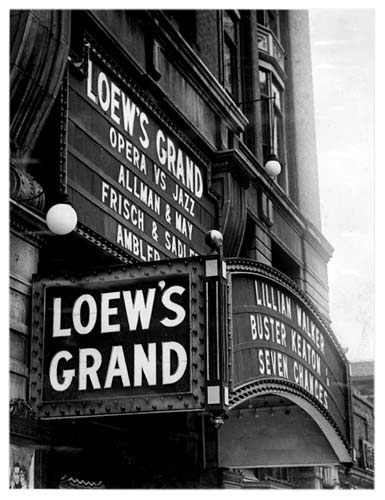 -
In November of 1978, the Loew's Grand
(originally
the DeGive Grand Opera House) is shuttered. A few
weeks
later in late December, a fire ravaged the building. The cause
of the fire was determined to be homeless people who started a
fire to keep warm, although there were some dubious circumstances
that raised the possibility of arson. Among those in the crowd
watching the fire was Laurent DeGive's grandson, who had recently
sold the building to developers. The auditorium of the Grand was
located on the bottom floors of what was a multi-story building.
The fire was in the upper offices that the fire originated and
while the auditorium did not get any direct fire damage, the
structure's
integrity was so badly damaged by the fire the building had to
be demolished. After the building is razed, bricks from the fascia
are sold as souvenirs with engraved plaques fastened to them touting
the Grand as the site of the world premiere of Gone With The Wind.
The bricks prove to be very popular.
-
In November of 1978, the Loew's Grand
(originally
the DeGive Grand Opera House) is shuttered. A few
weeks
later in late December, a fire ravaged the building. The cause
of the fire was determined to be homeless people who started a
fire to keep warm, although there were some dubious circumstances
that raised the possibility of arson. Among those in the crowd
watching the fire was Laurent DeGive's grandson, who had recently
sold the building to developers. The auditorium of the Grand was
located on the bottom floors of what was a multi-story building.
The fire was in the upper offices that the fire originated and
while the auditorium did not get any direct fire damage, the
structure's
integrity was so badly damaged by the fire the building had to
be demolished. After the building is razed, bricks from the fascia
are sold as souvenirs with engraved plaques fastened to them touting
the Grand as the site of the world premiere of Gone With The Wind.
The bricks prove to be very popular.
This is where the fates of the Fox and the Loew's Grand cross. The Grand had operated as the Loew's flagship movie house up till the time it closed, so its equipment was relatively new and in much better condition than that of the Fox. The Grand had "modern" 35mm projectors. Since the Fox had much older projectors that were in need of replacement, Atlanta Landmarks purchased the projection equipment from the Grand. In addition, the Fox had found itself in a seating numbers game with other venues in Atlanta, such as the Civic Center. The more seats a house had, the more appealing it was to promoters. The Fox staff determined that it was possible add a few hundred additional seats to the auditorium in the very back of the balcony on the rear floor of the Gallery level. The Fox bought several rows of seats from the Grand. These seats are readily identified, as they do not have the ornate cast iron sides the original Fox seating have.
1979: The Fox celebrates its 50th birthday in grand style. The theater was opened to the public for free tours; silent movies were shown along with accompaniment by the organ. A big birthday cake was created and after signing Happy Birthday, it was cut and served to everyone in attendance. After 50 turbulent years, the Fox had been saved, it was making a good profit for itself, and its future looked brighter than ever. A set of plaques is mounted in the Arcade to recognize the saving of the Fox, the people who were major contributors to the Fox, and the Fox's 50th anniversary.
- The Board of Directors of Atlanta Landmarks make an offer to Joe Patten to live at the Fox Theatre. The plan is for Joe, at his own expense, to refurbish what was the original area used as the Shrine's Potentate and Recorder's Offices into a 3,600 square foot, two story apartment. At the time, Joe spent all of his waking hours at the Fox and this made a lot of sense including the fact that his continued presence at the Fox Complex would let him act as a night watchman for the building. In 1996, this proved invaluable as he detested a fire that could have been catastrophic. It is stated that Joe spent over $50,000 of his own money to renovate the area. A lease was signed that allowed Joe to live in the apartment at the Fox for the remainder of his life, plus 60 days (for his estate to be taken care of) for the cost of his renovations of the apartment.
- The local CBS affiliate, WAGA-TV Channel 5, produces a one-hour tribute to the Fox, "The Fox at Fifty". It is aired in primetime just before the actual 50th anniversary. (In the 1990s, WAGA changed its network affiliation to the FOX Network.)
1981: Ed Neiss becomes the third General Manager under Atlanta Landmarks' ownership of the Fox on October 26th. To his credit, the Fox enjoys a very successful run under his tenure of over 23 years.
Mr. Neiss becomes GM the same day The Rolling Stones play the Fox for a second time. The Stones take a field trip to Savannah the day of the concert, but when they return to Atlanta, the city is socked in by fog and they are re-routed to Macon, 90 miles south of the city. The show starts 90 minutes late. The Stray Cats were the warm up act.
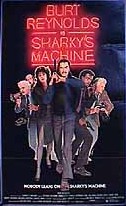 1982:
In the public areas, the carpet was
in dire need of replacement. With the use of remnants of the original
carpet found tucked away in different places in the building along
with black and white photographs taken just before the Fox opened
in 1929, Restoration Director Rick Flinn was able to figure out
the many different patterns that were used in the building. Bids
went out to have the carpets made and a company from Ireland was
chosen for the job. The carpet found its way to Atlanta from the
Emerald Isles and was mostly installed by the time of the world
premiere of Burt Reynold's "Sharky's Machine"
in 1982.
1982:
In the public areas, the carpet was
in dire need of replacement. With the use of remnants of the original
carpet found tucked away in different places in the building along
with black and white photographs taken just before the Fox opened
in 1929, Restoration Director Rick Flinn was able to figure out
the many different patterns that were used in the building. Bids
went out to have the carpets made and a company from Ireland was
chosen for the job. The carpet found its way to Atlanta from the
Emerald Isles and was mostly installed by the time of the world
premiere of Burt Reynold's "Sharky's Machine"
in 1982.
- The first major renovation and construction project began at the Fox, funded in part by a $200,000 grant from the United States Department of Housing and Urban Development. This undertaking affected the entire front section of the Fox complex from about halfway down the Ponce side of the building, all the way down the Peachtree Street side. The Fox needed a proper office area from which the buildings affairs could be administered. Prior to this time, there was a single office located off the main lobby floor. If the building was closed, someone had to go to the main doors in the arcade and pound loudly until someone heard them to and let them in. The office space was designed with 5 offices, a reception area, and a large conference room located on a second level. The reception area occupied Bay 1 of the storefront areas, located on Ponce DeLeon Avenue. A storefront window bay in the arcade closest to the main entrance to the Egyptian Ballroom was reworked to be the new reserved ticket purchasing location.
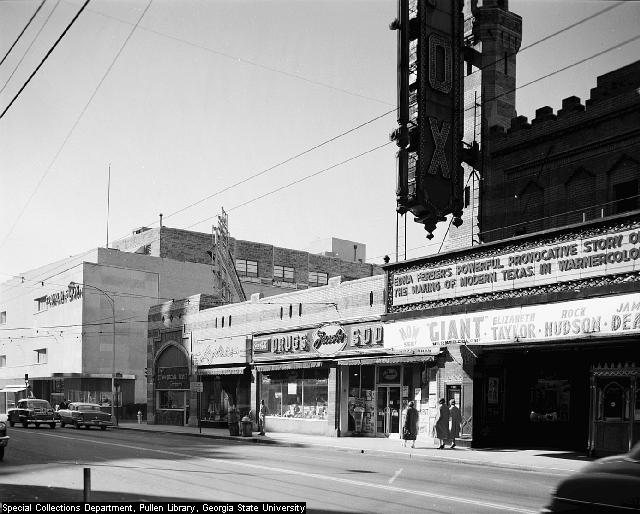 Over
the years, many different merchants had used the retail storefront
"bays". Over the years, the storefronts were modified
from their original version. The stores were excavated; the storefronts
were totally removed and rebuilt to how they looked in 1929. A
baker named Hank Azor, who was considered the "Official
Caterer to the Fox", rented one of the Fox's
kitchens
and opened a bakery on the northern end of the store fronts in
Bay 9. A restaurant opened in the bays at the Peachtree-Ponce
corner of the building. In the early 1990s, when Hank Azor died,
the family closes the bakery. The photo to the right shows the
left side of the Peachtree Street facade and how it was altered
in this photo dated to 1956.
Over
the years, many different merchants had used the retail storefront
"bays". Over the years, the storefronts were modified
from their original version. The stores were excavated; the storefronts
were totally removed and rebuilt to how they looked in 1929. A
baker named Hank Azor, who was considered the "Official
Caterer to the Fox", rented one of the Fox's
kitchens
and opened a bakery on the northern end of the store fronts in
Bay 9. A restaurant opened in the bays at the Peachtree-Ponce
corner of the building. In the early 1990s, when Hank Azor died,
the family closes the bakery. The photo to the right shows the
left side of the Peachtree Street facade and how it was altered
in this photo dated to 1956.
1984: The Fox Theatre is the site for the League of Women Voters' 1984 Democratic Presidential Nominee Debate. This debate was broadcast live and narrated by NBC journalist John Chancellor. The candidates included the Reverend Jesse Jackson, Senator and former Astronaut John Glenn, Gary Hart, Alan Cranston, Fritz Hollings, George McGovern, Reubin O'Donovan Askew, and the eventually nominee, Former Vice-President Walter Mondale. In the general election that fall, Mondale lost to Ronald Reagan
1985: The Möller organ goes through another period of work. Because the Fox Theatre was not quite completed before "Black Monday", the start of the Great Depression, many businesses that were contracted to provide equipment and fixtures for the Atlanta Fox went out of business or ceased to operate for a period of time. The paperwork from the Möller Organ Company regarding the organ showed that there were several sets of pipes that were not installed. With the Fox "saved", the theatre was finally able to purchase the pipes that never made it to the Fox back in 1929. When complete, the Möller was able to create even more thrills with its expanded range of sound. After a complete check out, the organ is found to be in remarkable condition. Whereas in 1963 the majority of its over 8000 wires going from the console were damaged, only one wire was in need of repair.
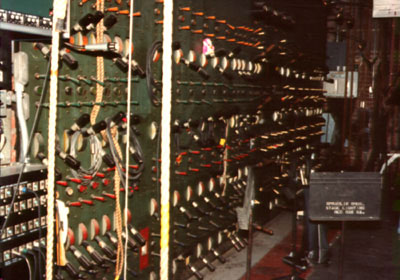 -
It was being recognized that the demands of a
modern
performance were beginning to tax the stage electrical system.
The stage gets state-of-the-art lighting and sound equipment.
It is another testament to the buildings design that the equipment
installed in 1929 worked perfectly until it was replaced. In the
projection booth, modern Dolby Digital Surround Sound equipment
was purchased to complete the technical upgrades the Fox required
in order to host the premiere of motion pictures. Until that time,
a surround sound decoder had to be borrowed or rented when the
theater was used for a premiere.
-
It was being recognized that the demands of a
modern
performance were beginning to tax the stage electrical system.
The stage gets state-of-the-art lighting and sound equipment.
It is another testament to the buildings design that the equipment
installed in 1929 worked perfectly until it was replaced. In the
projection booth, modern Dolby Digital Surround Sound equipment
was purchased to complete the technical upgrades the Fox required
in order to host the premiere of motion pictures. Until that time,
a surround sound decoder had to be borrowed or rented when the
theater was used for a premiere.
- As I previous stated, when the Fox began offering live performances, the Fox found itself in competition from other venues to host performers. In the beginning, the Fox seated about the same amount of people as the Atlanta Civic Center, The pecking order for the number of seats was:
The Fox was so close to the size of the Civic Center; they often found themselves in contract competition between themselves. Adding the 125 or so seats from the Loew's Grand did help, but not that much. Being a National Historic Landmark meant that the Fox needs to be restored back to the way it was back in 1929. In 1965, the Fox's orchestra level seats were replaced with much larger units that reduced the orchestral seating capacity by about 500.
Before new ones were sourced, a search was performed to see if the originals still existed somewhere. It was possible that they could have found their way into another theater, auditorium, or even a church. Fate was kind and they were found. Unfortunately, they were in a pasture in a terrible state of decomposition and were not salvageable. Bids went out and as it turned out, the original manufacturer of the Fox's seats was still in business and made the lowest bid.
Replacing the seats wasn't just a case of ordering news ones and bolting them in. When the old seats were removed, the concrete floor had to be re-worked in order to accommodate the configuration of the additional rows. The process took over two months, but when it was done, the Fox could now seat 4,518 patrons.
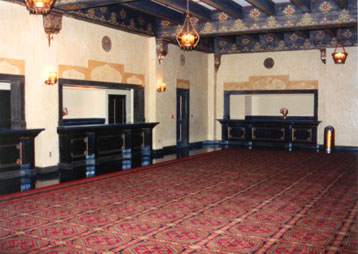 1986:
The most ambitious renovation project at the Fox
was
the "re-purposing" of the Fox's third ballroom space,
the Spanish Room. The room was not designed as a ballroom, but
rather a rehearsal hall for the house orchestra and dance troupe.
Surrounding the room were four private rooms with an adjacent
hallway. Below the room was a kitchen along with dressing rooms
and communal showers. While the kitchen was used, the rest of
the area had not been for decades. One of the worst problems the
Fox endured during a performance was the crowds that would gather
in the lobby for concessions. While the centrally located and
large round concession stand made sense during its movie house
years, it was now a great hindrance. In the 70s, Bruce Sutka built
a smaller, secondary concession stand on the Mezzanine level to
reduce traffic at the lobby level. While it did help, it only
took away a small portion of the demand from the main stand.
1986:
The most ambitious renovation project at the Fox
was
the "re-purposing" of the Fox's third ballroom space,
the Spanish Room. The room was not designed as a ballroom, but
rather a rehearsal hall for the house orchestra and dance troupe.
Surrounding the room were four private rooms with an adjacent
hallway. Below the room was a kitchen along with dressing rooms
and communal showers. While the kitchen was used, the rest of
the area had not been for decades. One of the worst problems the
Fox endured during a performance was the crowds that would gather
in the lobby for concessions. While the centrally located and
large round concession stand made sense during its movie house
years, it was now a great hindrance. In the 70s, Bruce Sutka built
a smaller, secondary concession stand on the Mezzanine level to
reduce traffic at the lobby level. While it did help, it only
took away a small portion of the demand from the main stand.
Restoration Director Rick Flinn came up with a plan that if I remember correctly, cost 5 million dollars. A portion of the wall between the lobby and the Spanish Room area was removed so there would be direct access to the Spanish Room from the auditorium lobby. The rehearsal rooms and the restrooms were gutted and the floor to a hallway and the rehearsal rooms was removed. A floor was laid 38 inches lower from its original height to match the level of the auditorium floor. A stairway was built leading up to the main Spanish Room area from the new lower floor. Alongside the Spanish Room is an ADA-compliant ramp and new handicap accessible restrooms located in front of the Spanish Room in what used to be a portion of the old storefront bays to the right of the arcade. A new exterior wall was made that extended out approximately 8 feet from the northern exterior wall of the building. This was done to make concession service areas that were recessed in the existing Spanish Room Walls. Three additional concession service points were made in the western and eastern walls of the Spanish Room. The extension of the northern wall also served an alternate purpose. The Fox employs metal fire escapes on the northern side of the building for quick exit from the right side of the auditorium and the Egyptian Ballroom. The new wall substantially cleaned up the look of the northern side of the building. Since that side of the building was now exposed to a large open-air parking lot, this was a big deal.
The entire project took over two years to complete. Rick Flinn had to pay exacting detail to everything in order to make the new work look like it was part of the building from the beginning. Once the room was completed, the old concession stand was removed from the center of the lobby to allow for a much more open public space.
- An elevator was added to the Grand Staircase for ADA compliant access to the Egyptian Ballroom and Grand Salon. Up to that time, there was no handicapped accessible way to get to either of these rooms.
1987: Atlanta Landmarks launches the "Fix the Fox" campaign to raise funds to "raise funds to improve safety code compliance, better equip the building to operate efficiently, and to preserve it structurally." The campaign successfully raised over 4.2 million dollars.
1988: The completed Spanish Room Concession Area project is completed and dedicated in October of 1988: A plaque commemorating the room to the memory of Ben J. Massell Jr. is embedded in the western wall of the room. Massell was the most generous patron ofthe Fox during its "Dark Days". He contributed under anonymity $400,000 during the initial "Save The Fox" drive. This was the pivitol large donation that caused other private and corporate donations to be given to the Fox. 1.5 million dollars was donated to the Fox in Massell's name and memory for the Spanish Room project.
1989: The Fox is designated a Landmark Building of Atlanta.
- The 50th anniversary re-premiere of Gone With The Wind is held at the Fox. The Fox facade is transformed into a reproduction of Tara. Original stars, including Butterfly McQueen and Evelyn Keyes, attend the gala.
- On December 14th, the Yaarab Temple returned to the Fox to celebrate the centennial anniversary of its founding.
1991: The Fox is designated a National Landmark Museum Building.
1992: A Rick Flinn steps down from the Restoration Director's position and begins his own private architectural firm. His influence on the Fox during his tenure was profound. Mr. Flinn accepts a position on the Board of Directors of Atlanta Landmarks.
- Mary Catharine Martin assumes the Restoration Director's position.
1996: On Monday, April 15th, three months before the Centennial Olympic Games in Atlanta, disaster strikes the Fox. An electrical fire broke out in the ceiling of "Adams at the Fox"; the restaurant located in Bays 2 & 3 at the corner of Peachtree and Ponce DeLeon. After smoldering in an electrical junction box, it broke out and eventually became a four-alarm fire. This occured in the very early morning hours. The fire alarm woke up Joe Patten in his apartment and he contacted the fire department. Thanks to the efforts of the Atlanta City Fire Department, the fire was contained during the over 8-hour firefight. By noon, the fire had finally been contained and was under control.
What turned out to be a saving feature of the building was a solid brick wall that ran the length and height of the building between the auditorium and the office/bay areas. During the fire, it acted like a firewall and prevented the fire from intruding in the auditorium. When it was all over, the Auditorium, the Grand Salon, and Joe Patten's personal apartment suffered minor water and smoke damage, but the roof, restaurant, Bays 4 & 5, and the operational offices were totally gutted. The fire had caused over two million dollars worth of damage to the Fox.
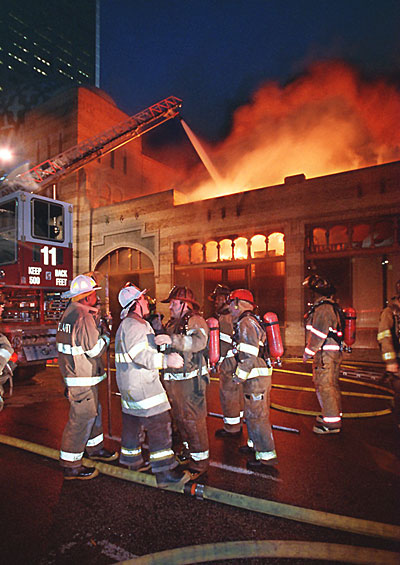
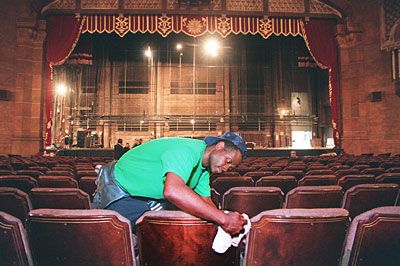
The good news was that the fire was located in one of the least critical areas of the building. After an intense 36-hour clean-up, the Fox returned to operational status the day after the fire. General Manager Ed Neiss ordered a full page ad in the Atlanta Journal-Constitution to thank the Atlanta Fire Department for saving the Fox and to notify the public that the opening of the stage play; Joseph and the Amazing Technicolor Dreamcoat would go on as scheduled.
As with most times adversity had stricken the Fox, it not only overcame the situation, but also in some ways benefited from it. The restaurant space was been rebuilt and a new restaurant reopened in place of the old one. The offices were not only rebuilt, but also expanded. The Fox's main office entrance was relocated to the Peachtree St. bays (4 & 5) next to the restaurant. After residing in bays 7 & 8 during reconstruction, the Box Office returned to its prior location in the Arcade with an additional ADA compliant service window located next to the main window.
During the construction of the new offices, a new structure is added to the roof in front of the Grand Salon. In one portion of the structure, is a huge skylight that illuminates part of the new offices. Another part of the structure contains elevators that I assume go down to the Arcade level to a connecting hall that leads to a set of new doors in the Arcade. The new structure sits across from the Grand Staircase on the other side of a terrace that was originally part of the building, but not used for decades. The terrace used to have a connecting walkway to another terrace for the Egyptian Ballroom. The new structure was built where that was. The Fox now refers to this area as "The Terrace" and it is available as an individual rental area. Construction of the terrace area was completed in 1999.
A few months after the fire, the Fox Theatre held a tribute dinner for the firemen that worked the fire on the main stage of the auditorium to show their appreciation of the firefighter's hard work that saved the Fox from total destruction. .
Webmaster's Note: Photo credit of the three1996 Fox fire images are from the Atlanta Journal-Constitution's website.
- The Fox serves as the headquarters for the Australian Olympic Committee during the 1996 Centennial Olympic Games in July and August.
2001: Mary Catherine Martin steps down as Restoration Director of the Fox. In her place, Molly Fortune becomes the Preservation Director of the Fox Theatre.
2002: In the Summer Larry Douglas Embury is invited to become Organist in Residence at Atlanta's Fox Theatre, filling the position that had been vacant since Bob Van Camp's death in the late 1980s.
2003: The Fox Theater is designated a "Smoke-Free" building. The plaster and cement ashtrays are removed from the public areas. During performances, people are allowed to go outside on the Ponce DeLeon "porch" to smoke, should they feel the need to.
- Churchill Grounds, a lounge, opens in Bay 9. A secondary room for the lounge, dubbed, The Whisper Room, is built in bays 7 & 8 where the Box Office was. The Fox management staff now operates the restaurant on the Ponce corner of the Fox.
2004: After renovations are performed on both the exterior and interior of the building, the Cox-Carlton Hotel is reopened as Hotel Indigo.
- Georgia Public Television premieres "The Fox Theatre", a 60-minute documentary on the history of the Atlanta Fox Theatre. The documentary is made available as a home video with a secondary documentary "This Old Movie Theatre" that details the Fox's restoration efforts, photographs and other supplemental information. On the DVD edition, there is a companion disc that contains another 2002 documentary: "Peachtree Street: Take Another Look", a Virtual Tour of the Fox, A close-up look at the Möller Organ, star stories, and a behind the scenes look at the Atlanta Ballet's production of the Nutcracker, which is now an Atlanta tradition at the Fox. The DVD is available at the Fox and through the GPB website.
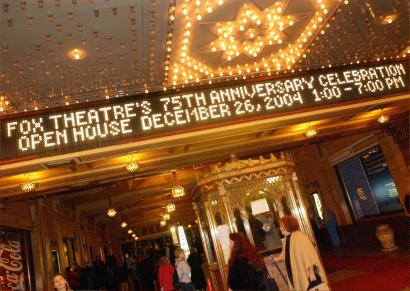
- On December 25, 2004 the Fabulous Fox Theatre celebrates the 75th anniversary of its grand opening. The next day, December 26th, the Fox officially celebrated it's birthday with a 6-hour gala open house. After a 15-minute ceremony under the Marquee, Comedian Jeff Foxworthy cut a ceremonial ribbon as a canon fired metallic streamers into the air above the marquee. The huge crowd in attendance (over 15,000) quickly filled the Fox to over capacity, causing a huge crowd to stand outside in the cold for hours in order to get a chance to get inside. It is estimated that over 15,000 people came to be a part of the celebration.
2005: Edgar Neiss retires as the General Manager of the Fox Theater after a 24 year tenure at the end of 2005. Mr. Neiss has the distinction of being the longest-tenured GM of the Atlanta Fox, surpassing Arnold Noble's tenure of 19 years. It is without question that during Mr. Neiss' tenure, the Atlanta Fox enjoyed its most profitable and successful period of operation to date.
2006: On March 20th, it was announced that Allan C. Vella, former general manager of Ford Park in Beaumont, Texas, will assume the position of General Manager of the Atlanta Fox Theatre effective July 1. Previously, Vella managed the Fox Theatre in Detroit for four years.
After a very tumultuous first fifty years, the Fox has enjoyed good fortune and prosperity for the next 25. I certainly hope that the next 75 years will be as good as the last 25.
2010: In the summer of 2010, Joe
Patten, then 83, was not properly in control of his
Diabetes and
this caused him some severe health issues. He was found in
"distress" by Fox staff members and was taken to
Emory Midtown/Crawford Long Hospital. There he was diagnosed as having
suffered a minor
stroke. Fortunately, there were no lasting complications but he was
retained in healthcare for 20 days as a precaution. During that time,
the Board of
Directors of Atlanta Landmarks and the management staff of the
Fox felt that Joe needed to be removed from his apartment at the Fox
and placed into a senior care living center. During his hospital stay,
Members of the Fox staff and the Landmarks Board visited Joe, telling
him he
could not return to his apartment, despite Joe's doctors stating that
he was in good health and could continue his regular schedule. Joe was
determined to remain in his home and refused to move from
his home of over 31 years. When he returned to his apartment,
he
was given a hand-delivered letter from the President of AL informing
him he had to move. By this time, the news of what was going on reached
the public eye. There were news reports on both local and
national
news
services. A grass-roots campaign "Save the Phantom of the Fox" was born
and began public protests over Joe's potential eviction.
On
September 2nd, The Atlanta Landmarks Board held an emergency session to
decide the fate of Joe and his apartment. Joe was not allowed to defend
himself and a one-sided presentation was given to the board members in
attendence. While there was a clause in the lease that covered a
forceful eviction from the apartment due to health concerns, the Board
chose to use a
general termination clause and the majority in attendence voted in
favor to terminate the lease.
Joe was heartbroken and lamented he should have let the building burn
to the ground back in 1996.
Joe Patten had retained Emmet
Bondurant, a prominent Atlanta attorney to represent him in the battle
to retain his home. At the Board meeting that terminated his original
lease, the Board offered Joe a new alternative lease that would have
allowed him to live at the Fox with strict limitations as well as the
lease being terminated at any time if that was the will of the Fox
management. Mr. Bondurant instructed Joe not to sign the new lease.
After a month, Mr. Bondurant filed a law suit against the Fox
Theatre and
Atlanta Landmarks. In his filing, he contended that the termination of
Joe's lease violated several federal and state laws the prevented
handicap and age discrimination. He further claimed violations of
corporate law in how Landmarks voted in favor of eviction. Mr.
Bondurant also filed for an immediate injunction to
put back in place the original lease and to prevent the Fox management
to do anything that would further harm Joe or his apartment.
On October 27th, The judge allowed the injunctions to be put in effect and ordered Atlanta Landmarks to enter into earnest negotiations with Joe and his lawyer to resolve the matter before a hearing date was scheduled. In the Fall of 2011, it was announced an agreement had been reached between the Fox and Mr. Patten that allowed him to continue living in his Fox apartment for the foreseeable future. As of January, 2013, Joe still resides at the Fox and is in good health.